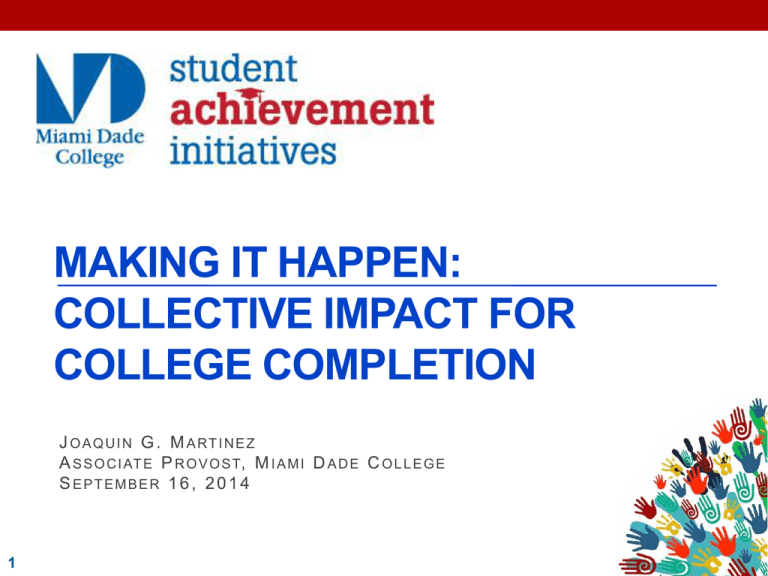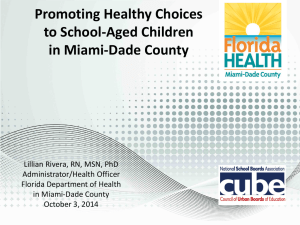MAKING IT HAPPEN: COLLECTIVE IMPACT FOR COLLEGE
advertisement

MAKING IT HAPPEN: COLLECTIVE IMPACT FOR COLLEGE COMPLETION J O A Q U I N G . M A RT I N E Z A S S O C I AT E P R O V O S T, M I A M I D A D E C O L L E G E S EPTEMBER 1 6 , 2 0 1 4 1 Workshop Objectives • Review Student Achievement Initiatives (SAI) at Miami Dade College • Review ¡HACER! • Share a framework for replication 2 What is SAI? • The goal of the Student Achievement Initiatives (SAI) is to substantially increase student success and completion while maintaining access and quality. • After an initial year-long data review and planning process, MDC developed a 2-year implementation plan focused on creative integrated academic and student services solutions to help more students successfully complete a college degree or certificate program. • These strategies have fostered the success of students starting at MDC in any one of our three entry points: college-ready, developmental education, and English for Academic Purposes (EAP). 3 BARRIERS 4 IMPLEMENTATION STRATEGIES • Create a more structured intake process. • Develop and utilize structured curriculum pathways with • • • • 5 sequential coursework and focused course choices. Increase forward momentum, especially in developmental education and English for Academic Purposes (EAP). Increase transition assistance from developmental education and EAP into college-level programs of study and from there into transfer and/or career outcomes. Integrate academic and student support programs aligned with learning outcomes. Increase student engagement through participation in communities of interest. 6 YEAR-1 ACCOMPLISHMENTS 7 Academic Pathway Redesign First Year Experience (FYE) Course Mandatory Orientation 2.0 Boot Camps 2.0 Multiple Measures Pilot Developmental Education Redesign Registration Deadline Where we are now… Coaching & Mentoring Pre-college Advisement Mandatory Orientation Adoption of New Technology Platforms 3-Tiered Coaching & Mentoring Model Advisor Training Academic Pathways FYE Courses Initial Components of Communities of Interest Test Prep Boot Camps Developmental Education Redesign 3-Tiered Advising Model Supports Student Pathway Tier 1 Admissions through Orientation Orientation through 25% Benchmark Tier 3 9 25% Benchmark through Graduation Tier 2 Tier 1: Admission Through Shark Start Orientation Pre-College Advisors prepare students for a strong start at MDC. Activities: On-site advising at 46 high schools; financial aid information; career-focused workshops; outreach/ connections; documentation reminders; academic enrichment opportunities. Early Results: applications and enrollment both increased by ~15% in 2013 10 Tier 2: Shark Start Orientation Through 25% Benchmark Senior Advisors support students to create academic/career plans aligned with skills and interests. Activities: Mandatory orientation, engagement activities, non-cognitive and career assessments, one-on-one advising, Individual Educational Plan (IEP). :Early Results • ~30,000 FTIC students attended mandatory orientations to date • ~ 90% of all new students assigned an advisor and completed IEP • Fall to Spring and Fall to Fall retention increased each year 11 Tier 3: 25% Benchmark to Graduation Academic Coach/Mentors support students with more specific academic and career advice linked to program of study. Activities: Monitor IEP completion, academic progress reviews, service learning and internship opportunities, transfer and career planning, mentorship. Early Results: • ~ 6000 students successfully reached 25% benchmark and transitioned to coach/mentor. • ~ 250 faculty, department advisors and chairpersons volunteered to be coach/mentors. 12 Integrated Academic and Student Support Services QEP 3 Tier Advisement Learning Outcomes SAI Communities of Interest (COI’s) • A COI represents a clustering of students who demonstrate a common interest and have similar academic and/or career goals • Services and initiatives within the COI support the identity, purpose and objectives of this target group of students to enhance program persistence and completion • Focus on co-curricular and career exploration activities • New position has been created to support the development of the Communities of Interest across the College. Data Driven Enhancements Evaluate Intervention Make Course Corrections Analyze Results Identify Areas for Improvement 15 Measuring Impact • MDC has built capacity for using data to: • Inform decision-making and problem-solving • Integrate academic and student services more effectively • Innovate and take calculated risks • Learn and improve upon early execution • Reallocate resources more strategically • Guide and embrace positive changes • Deliver results • Scale best practices • Now that the SAI framework has been shared, we will review ¡HACER! as a particular example of how SAI influences long-term institutional sustainability. 17 • ¡HACER! is the Spanish word for “TO DO.” • The ¡HACER! Project (Hispanic Access to College Education Resources) is a large collaborative effort facilitated by Miami Dade College that is designed to increase the post secondary attainment rates of Latinos in Miami-Dade County. • The effort is a 4-year $600,000 grant program funded by the Lumina Foundation Latino Student Success Initiative. • The project is currently in Year 3 of the grant life cycle and Year 2 of program implementation. ¡HACER! Program Goals • (Short Term Goal) •To create a college going culture in the Miami-Dade County Community . • (Intermediate Goal) •To increase the number of Latino Students who graduate from high school and are properly prepared for postsecondary studies. •(Long Term Goal) •To increase the proportion of Latinos in Miami-Dade County who hold high quality college degrees, certificates, or other credentials to 60% by the year 2025. • *Goal 2025 is a nationwide education attainment goal that if met, will enable students to effectively compete in today’s global workforce and create a stronger America and a stronger Miami-Dade County. Why ¡HACER!? Education is society’s great UNIFIER; and statistically, as a community, we are at a disadvantage. The State of Miami-Dade County •61% of Latinos in Miami-Dade County only have a high school diploma. •Currently, only 38% of Latinos in Miami-Dade County hold a college degree. •Only 22.4% of Latinos earned a BS/BA degree, compared to 45.3% of non-Latino whites. (U.S. Census Bureau, American Community Survey, 2010) Bachelors Degrees NonLatino 22.4% 45.3% Latino MDCPS MDC & FIU The Education Fund uAspire Single Stop USA College Summit Univision New Futuro College Readiness Institute ¡HACER! Partnership Resources & Services ¡HACER! resources and services flow directly into the six targeted schools Booker T. Washington Miami Beach Homestead Senior The circular flow represents the creation of the well-prepared student who is equipped to successfully navigate the educational pipeline to college completion The flow of information and knowledge from ¡HACER! activities and interventions conducted through the high schools HIGH SCHOOL GRADUATE COLLEGE STUDENT COLLEGE GRADUATE FAFSA & Registration Marathons College Tours Mentoring & Tutoring Faculty & Staff Professional Development Financial Literacy Workshops College Clubs Curriculum Alignment Summer-Bridge Programs Student & Parent Workshops (Cognitive & Non Cognitive) Test Prep Courses (Boot Camps) !HACER! Website A Community Commitment to College Readiness and Student Success • The partnership includes a host of partners that work collectively to impact college readiness and student success in the Miami-Dade community. • The partnership provides college readiness resources and services to • • • • • • six high schools in the Miami Dade County Public School System: Booker T. Washington High School Homestead Senior High Miami Beach Senior Miami Jackson Senior Miami Southridge Westland Hialeah 11 & 12 grade students Expect to serve over 18,000 students Year 1 Outcomes (2012-2013) Moving Forward This year we are continuing the work and building upon promising efforts to significantly “move the needle” in postsecondary attainment for our community. Discussion Activity • Pair up with 3-4 other participants and take a few minutes to address the following three prompts: 1. Explain how some of these strategies could be useful at your institution. 2. Are there some strategies that may not work at your institution? Why? 3. How would you overcome some of the identified barriers to implementation at your institution? 27 Questions? 28 For additional information: • Contact: Joaquin G. Martinez Associate Provost, Miami Dade College joaquin.martinez@mdc.edu (305) 237-7191 29


